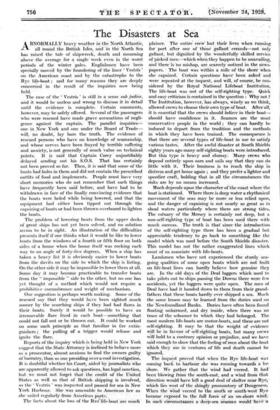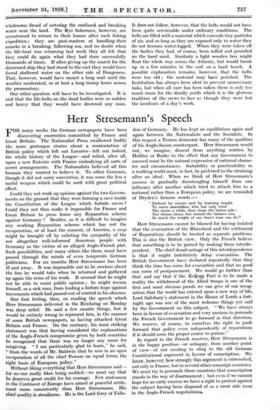The Disasters at Sea
A BNORMALLY- heavy weather inthe North Atlantic, all round the British thE North Sea has raised the tale of diip*reck, death and mourning above the average for a single-Week even in the worst periods of the winter -gales. Englishmen' have been specially moved by 'the foundering of the liner Vestries-' on the American coast and by the catastrophe to the Rye life-boat ; and for `many reasons they are deeply concerned- in the result of the inquiries now being held.
The case of the.' Vestris ' is still in a sense 'sub judice, and it would be useless and wrong to disCuss it in detail until the evidence is coniplete. Certain comments, however, may be safely offered. Several of the passengers who were rescued have made grave accusations of negli- gence against the captain. The parallel inquiries---- one in New York and one under the Board of Trade— will, no doubt, lay bare the truth. The evidence of rescued persons who have no knoWledge of seamanship, and whose nerves have been frayed by terrible suffering and anxiety, is not generally of much value on technical points. It is said that Captain Carey unjustifiably delayed sending out his S.O.S. That has certainly not been proved so far: Then, it is said that some of the boats had holes in them and did not contain the prescribed outfits of food and implements. People must have very short memories who do not remember that such things have frequently been said before, and have had to be withdrawn in face of the finally convincing evidence that the boats were holed while being lowered, and that the equipment had either been tipped out through the capsizing of boats or had been thrown overboard to lighten the boats.
The problem of lowering boats from the upper decks of great ships has not yet been solved, and no solution seems to be in sight. An illustration of the difficulties presents itself if one thinks what it would be like to lower boats from the windows of a fourth or fifth floor on both sides of a house when the house itself was rocking each way to an angle of forty-five degrees, When a ship has taken a heavy list it is obviously easier to lower boats from the davits on the side to which the ship is listing. On the other side it may be impossible to lower them at all. Some day it may become practicable to transfer boats from the " impossible " side to the other, but no one has yet thought of a method which would not require a prohibitive encumbrance and weight of mechanism.
One suggestion is perhaps worth making. Some of the rescued say that they would have been sighted _much sooner by the searching ships if they had had flares in their . boats. Surely it would . be possible to have an irremovable flare fixed in each boat—something that could not fall out or be thrown out. It could be worked on some such principle as that familiar in fire extin- guishers ; the pulling of a trigger would . release and ignite the flare.
Reports of the inquiry which is being held in New York suggest that the State Attorney is inclined to behave more as a prosecutor, almost anxious to find the owners guilty of barratry, than as one presiding onera cool investigation. It is doubtful Whether his C,Mirt, aided by journalists who are apparently allowed to ask questions, has legal sanction, but we must not forget that the credit of the 'United States as well as that of British shipping is involved, as the Vestris was inspected and passed for sea in New York Harbour. She was amenable to American law as she 'sailed regularly from American ports. - The facts about the loss of the Rye life-boat are Much plainer. The entire CreW loSt their liveS when running for' port 'after one of this gallant- eritindsnot only gallant, biit dignified by -the wonderfully skilled Service of 'picked inen-which when they happen:#.6 be unavailing; and there is ho mishap, are scarcely naked in the nelis Paperi. - The boat was within a Mite of the Shore-When she' capsized,' Certain questiohs' have been asked and were- repeated at the inqiieSt, and *ill, Of course; C611- sidered by the Thiyal National Lifeboat Institution, The life-boat was not of the self-righting type: Quick and easy criticism is containedizi the question -Why not ? The Institution, hoWeVer,'ha.:s- alWayO, wisely as we think, allowed crews to ehoose their o*iitype Of bOat. After-all; it is essential that the crews should believe in their boat— should have confidence in it. Seamen are the most '-conServatiVe people in the world ; they can hardly be induced to depart from the tradition and the methods in which they have been trained. The consequence is that there are several tyPes o€ life-bhat in use to 'satisfy various tastes.- After the awful disaster atShuth Shields eighty years ago many self-righting boats were introduced. But this type is heavy and clu-msy: 'Many crews Who depend entirely upon oars and sails say that theY Can do little with it. Their business is to reach the ship in distress and, get home again ; .and they prefer slighter and speedier craft, holding that in all the Circumstances the risks are by no means increased. _ Much depends upon the character of the coast Where the boat is stationed. Where there is deep water a rhythinical movement of the seas may be more ,or less relied upon; and the danger of capsizing is not nearly so great as in shoal waters particularly where there are strong tides. The estuary of the Mersey is certainly not deep, but a non-self-righting type of boat has been used there with much success. The truth is that since the introduction of the self-righting type there has been a gradual but appreciable tendency to go back to something like the model which was used before the South Shields disaster.; This model has not the rather exaggerated lines which most of us associate with life-boats.
Landsmen who have not experienced the sturdy sea- _ going qualities' of some open boats which -are not built on -life-boat lines can hardly believe how genuine they are. Iri the old days of the Deal luggers which -used to take pilots out to ships passing the Downs' there were few accidents, yet the luggers were quite Open. The men of Deal have had it handed down to them from their grand- fathers that these boats hardly ever shipped a sea. Much the same lesson may be learned from the dories used on the-Newfoundland Banks. Dories have often been found floating unharmed, and dry inside, when there 'was no trace 'of the schooner to which they had belonged. The most Modern life-boats are motor. boats, and these are not self-righting: It may be that the weight of evidence Will be in' favour of -Self-righting boats, but many, crews will hold to a contrary opinion or prejudice, and we have said enough to show that the feeling of men about the boat Which they use in ventures of life and death cannot be- ignored: The inquest proved that ithen the Rye life-boat was coming back to harbour, she was running towards a lee, shore. We gather that the wind had Veered. It had been blOwing froth the south-east, and a wind from that direction would have left a good deal of shelter near Rye,- which lies west of the shingly proniontory 'of Dungeness. When the wind _veered to the south simith-West Rye became exposed to the full force 'Of an on-shore wind.- In such' circumstances a- deeP-ses seaman would • traVE-a wholesome dread of entering the confused and breaking water near the land. The Rye fishermen, however, are accustomed to return to their homes after each fishing exPedition ; they are past-masters at handling their smacks in a breaking, following sea, and no doubt when the life-beat was returning last week they all felt that they could do again what they had done successfully thousands of times. If after giving up the search for the distressed ship they had stood to the east they would have found sheltered water on the other side of Dungeness. That, however, would have meant a long wait until the weather moderated, or at best a "long 'tramp home across the promontory.
One other question will have to be investigated. It is said that the life-belts on the dead bodies were so sodden and heavy that they would have drowned any man. It does not follow, however, that the belts would not have been quite serviceable under ordinary conditions. The belts are filled with a material which conceals tiny particles of air, and so long as they are exposed only to water they do not become water-logged. When they were taken off the bodies they had, of course, been rolled and pounded On the hard sand. Similarly a light wooden box might float the whole way across the Atlantic, but would break up in a few minutes in the surf on a hard beach. A possible explanation remains, however, that the belts were too old ; the material may have perished. The Institution has always been alert to prevent unnecessary iisks, but when all care has been taken there is only too much room for the deadly perils which it is the glorious tradition of the crews to face as though they were but the incidents of a day's work.



















































 Previous page
Previous page